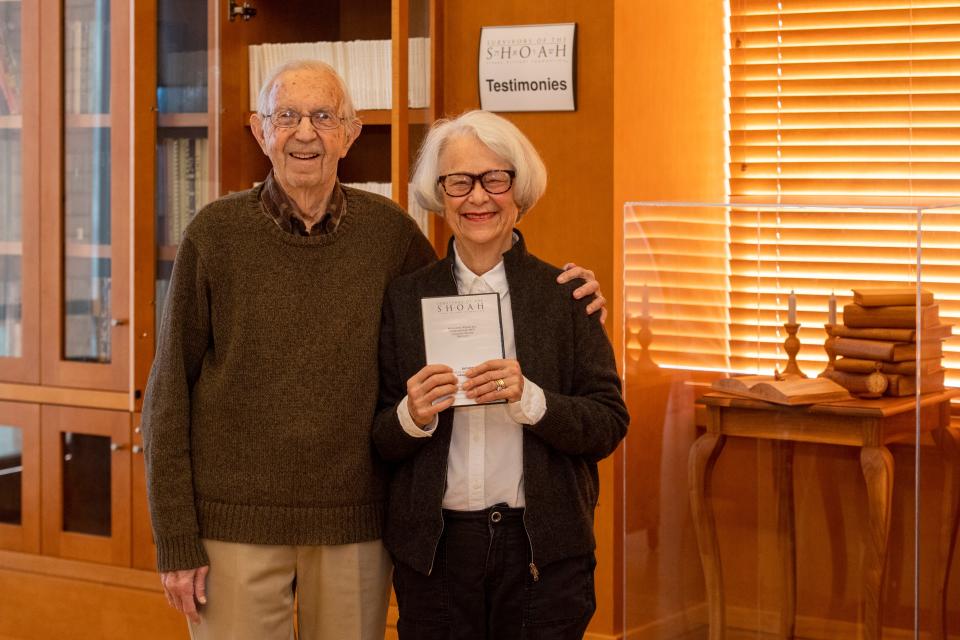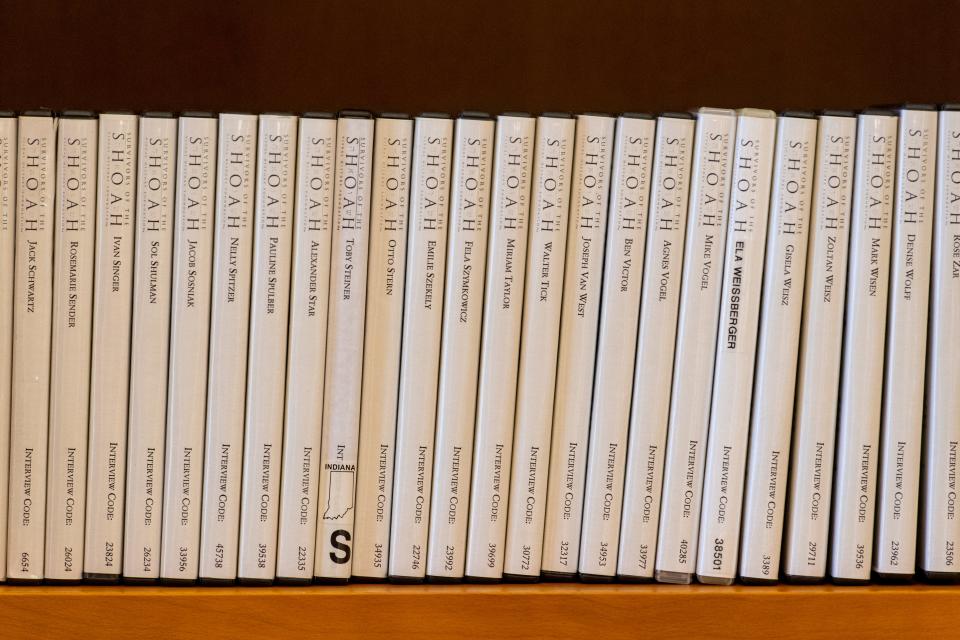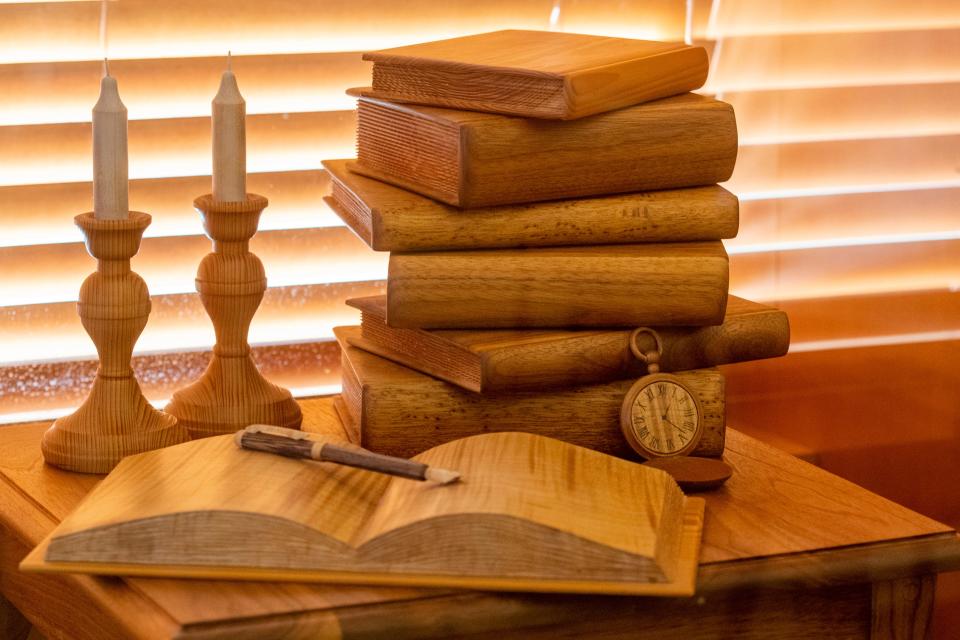With help from Spielberg and others, Evansville library maintains Holocaust survivor stories
EVANSVILLE − A Central Library bookcase contains shelves of DVDs with identical spines. Without description, no one would notice them, black type on a white label. Yet the ordinary holds the extraordinary.
The 115 disks contain stories of Holocaust survivors from Indiana, Kentucky, and Illinois (excluding Chicago) — stories of courage, desperation, deception, and hope of Jews who survived the Holocaust. The local collection is part of the University of Southern California’s Visual History Archive, funded by director Steven Spielberg’s Shoah (Holocaust in Hebrew) Foundation. Evansville was among the region's first to house stories, helped by a tenacious group of civic leaders and educators.
Six million Jews were killed by the Nazis in Europe during World War II, with only 300,000 of those in concentration camps surviving. Spielberg recognized how important it was to shine a light on this darkness for others to learn as the survivors pass.

Carol and Howard Abrams are long-time Evansville civic leaders and philanthropists. Carol is a founding member of the Committee to Promote Respect in Schools (CYPRESS). The group has brought teacher education, plays, and speakers here. Learning the Shoah Foundation sought regional repositories for the stories; CYPRESS began the process of bringing the archives to Evansville.
A dinner partner of Abrams spotted Spielberg at a nearby table while dining in New York. Abrams was eager to talk with the famous director about the group’s ongoing work with the Shoah Foundation. When Spielberg rose and headed to the back, Abrams looked at her husband and said, “Howard, you know what to do.”
Howard found Spielberg talking on a payphone. After the call, Howard said, “My wife has been working with Doug Greenberg (Shoah Foundation director) and would love to tell you about Evansville.” Spielberg agreed to visit the table.
“Their party came in after us, so we drank about 47 cups of coffee while waiting,” Abrams said.
Finally, Spielberg came to the table. Abrams told him about their group and plans for the Evansville repository.
Spielberg affirmed his commitment, “Outside of my children, nothing is more important to me than this.”
The conversation kindled a flame that still burns in our community. The testimonies arrived in 2005, according to Erik Estep, Local History Librarian for the Evansville Vanderburgh Public Library. The Evansville Central Library was among the first archives to hold DVDs instead of VHS tapes, which erode over time.
One testimony features Robert Melson’s boyhood in Poland, mirroring a gloomy 1940s film noir, with frequent moves, fake identification papers, family separation, disappearances, violence and death (including his grandparents in the Warsaw Ghetto).
His family hid in plain sight in Krakow, using papers his mother stole from the Zamojskis, a noble Polish family. A neighbor was a German SS officer who spoke often of killing Jews.

At age 6, Melson walked away from his mother at the Krakow train station, clasping hands with a stranger. Melson’s father was jailed in Prague, and his mother engaged a Christian stranger to care for Robert. His mother refused to know the boy’s whereabouts.
“I don’t want to know,” Melson recalled his mother saying. “It’s safer that I do not know in case I am tortured.”
If his mother didn’t return, the childless woman should adopt Robert. For months, Robert stayed with this kind woman and her husband while his mother, using false papers, got Robert’s father out of jail. Melson came to the United States with his parents and became a professor of political science at Purdue University.
Understanding the power of these stories, CYPRESS has advocated their use to community groups, students, and history buffs. Patrons may check out videos or view them onsite.
The Shoah Foundation project began in the 1990s after Spielberg was impressed by the Holocaust survivors he met while filming ‘Schindler’s List.” The global archives hold 56,000 testimonies.
Estep holds the collection close, as the testimony of his beloved Purdue University Professor Robert Melson is among those at Central Library.
“I’m hoping to speak with more teachers about the collection and up the usage,” Estep said. “It’s so important that we encourage the study of these videos. Historically speaking, rural areas have been isolationist, and it is vital to learn our history.
“Generally, we’re not doing a good job of teaching history in this disinformation age. These testimonies are people talking; they are primary sources.”
Estep encourages all, especially educators, to use the collection.
“The significance of first-person survivor testimony cannot be understated. We live in inauthentic times, and this authenticity is so important,” he said. “Oppression and genocide affect everyone because we are all a part of the human race.”
When the new Central Library opened in 2004, University of Southern Indiana professor and renowned wood sculptor John McNaughton learned of the videos after creating the large wooden hanging piece in the library’s central lobby. McNaughton gifted a sculpture to commemorate the testimonies in the Indiana Room.

“I was thrilled because I thought there should be some sort of artwork drawing attention to the archive,” said Abrams. McNaughton made a model of his vision — a table with books — and invited Abrams' thoughts. She suggested a pair of candlesticks to symbolize Friday night Sabbath candles and an old-fashioned pocket watch representing the passage of time.
“McNaughton borrowed my grandparents’ candlesticks and added a pocket watch courtesy of Goldman’s Pawn Shop,” Abrams said. The piece is named “Remembrance.”
In the early days of the exhibit, Abrams brought Nessie Godin, a Holocaust survivor from Washington, D.C., to speak at a teacher’s workshop. The art evoked the visitor's recollections, immediately reacting with a happy memory of a pocket watch. “When I was a little girl, I would sit in my Zaide’s (grandfather) lap, and he would hold his watch, just like this one, up to my ear,” said Godin.
A small beacon of remembrance shines the hope of survival and resurgence among a collection of man's inhumanity to man.
Editor's note: This article has been update to correctly identify Erik Estep, Local History Librarian for the Evansville Vanderburgh Public Library.
This article originally appeared on Evansville Courier & Press: Shoah Foundation has Holocaust survivor stories at Evansville library

